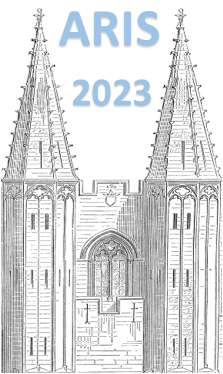Mlle
Jessica Warbinek
(GSI Helmholtzzentrum für Schwerionenforschung GmbH; Johannes Gutenberg-Universität Mainz)
Determining the limits of existence of the heaviest nuclides is a forefront topic in nuclear-physics research [1]. Nuclides with proton numbers $Z\geq$100 are stabilized by shell effects that retard spontaneous fission and they feature properties distinctly different from those of lighter nuclei. However, our understanding of such shell effects in the region of the heaviest elements is limited as predictions by state-of-the-art nuclear models are challenging and experimental studies are hampered by production capabilities. Recent mass measurements confirmed the location and the size of such a shell gap leading to an increased nuclear stability at neutron number $N=152$ in a region of strong prolate deformation [2,3].
Here, laser spectroscopy can serve as a powerful tool to extract experimental information on nuclear parameters such as the change in the mean-square charge radii and nuclear moments in a nuclear-model independent manner [4,5]. Access to the heaviest elements however is limited by production yields, their short half-lives and sparse information on atomic levels. The recent findings in the heavy actinide element nobelium ($Z=102$) with the RADRIS method paved the way for such observations [6,7].
New studies of fermium (Fm, $Z = 100$) isotopes allowed the determination of the isotope shift in an atomic transition for a long chain of eight isotopes ranging from the accelerator-produced $^{245}$Fm to the reactor-bred $^{257}$Fm. On-line and off-line laser spectroscopy techniques were significantly advanced to access these isotopes via various production methods down to minute production rates. The investigated isotopic chain spans across the known deformed shell gap at $N = 152$ allowing to probe its effect on changes in the mean-square charge radii. The experimental results revealing a discontinuity in the evolution of mean-square charge radii around the neutron shell gap will be discussed. These observations will trigger new developments in theoretical models which will eventually improve their predictive power towards the heaviest elements.
[1] W. Nazarewicz et al., Nat Phys 14, 537–541 (2018).
[2] E. Minaya Ramirez et al., Science 337, 1207–1210 (2012).
[3] C. Theisen et al., Nucl Phys A 944, 333–375 (2015).
[4] X. Yang et al., Prog Part Nucl Phys 129, 104005 (2023).
[5] M. Block et al., Prog Part Nucl Phys 116, 103834 (2021).
[6] M. Laatiaoui et al., Nature 538, 495–498 (2016).
[7] S. Raeder et al., Phys Rev Lett 120, 232503 (2018).
Mlle
Jessica Warbinek
(GSI Helmholtzzentrum für Schwerionenforschung GmbH; Johannes Gutenberg-Universität Mainz)
Elisabeth Rickert
(GSI Darmstadt / HIM Mainz / JGU Mainz)
Sebastian Raeder
(GSI Darmstadt)
Thomas Albrecht-Schönzart
(Florida State University)
Brankica Anđelić
(University of Groningen & Helmholtz Institut Mainz)
Julian Auler
(Johannes Gutenberg-Universität Mainz)
Benjamin Bally
(CEA - ESNT)
Dr
Michael Bender
(IPN Lyon)
Sebastian Berndt
(Johannes Gutenberg University Mainz)
Michael Block
(GSI/HIM/JGU)
Pierre Chauveau
(GANIL)
Bradley Cheal
(University of Liverpool)
Premaditya Chhetri
(Instituut voor Kern- en Stralingsfysica, KU Leuven)
Arno Claessens
(KU Leuven)
Antoine de Roubin
(KU Leuven)
Charlie Devlin
(University of Liverpool)
Holger Dorrer
(Johannes Gutenberg University Mainz)
Christoph E. Düllmann
(Johannes Gutenberg University Mainz, 55099 Mainz, Germany, Helmholtz Institute Mainz, 55099 Mainz, Germany, GSI Helmholtzzentrum für Schwerionenforschung GmbH, 64291 Darmstadt, Germany)
Julie Ezold
(Oak Ridge National Laboratory)
Rafael Ferrer
(KU Leuven - IKS)
Vadim Gadelshin
(Johannes Gutenberg-Universität Mainz)
Alyssa Gaiser
(Florida State University)
Francesca Giacoppo
(GSI Helmholtzzentrum für Schwerionenforschung GmbH)
Stéphane Goriely
(UInstitut d’Astronomie et d’Astrophysique, ULB-CP226, 1050 Brussels, Belgium)
Manuel J. Gutiérrez
(GSI Darmstadt / HIM Mainz)
Ashley Harvey
(Oak Ridge National Laboratory)
Reinhard Heinke
(CERN)
Fritz-Peter Heßberger
(GSI Darmstadt / HIM Mainz)
Stephane Hilaire
(CEA DAM)
Magdalena Kaja
(Johannes Gutenberg-Universität Mainz)
Oliver Kaleja
(GSI Darmstadt / MPIK / JGU Mainz / University of Greifswald)
Tom Kieck
(Johannes Gutenberg University Mainz, GSI Helmholtzzentrum für Schwerionenforschung GmbH)
EunKang Kim
(Johannes Gutenberg-Universität Mainz)
Nina Kneip
(Johannes Gutenberg University Mainz and Leibniz University Hannover)
Ulli Köster
(Institut Laue-Langevin)
M.
Sandro Kraemer
(Instituut voor Kern- en Stralingsfysica, KU Leuven)
Dr
Mustapha Laatiaoui
(HIM/JGU)
Jeremy Lantis
(HIM/JGU)
Nathalie Lecesne
(GANIL)
Andrew Mistry
(GSI Helmholtzzentrum für Schwerionenforschung GmbH)
M.
Christoph Mokry
(Department of Chemistry – TRIGA Site, Johannes Gutenberg University Mainz, Germany; Helmholtz Institute Mainz, Germany )
Iain Moore
(University of Jyväskylä)
Tobias Murböck
(GSI Helmholtzzentrum für Schwerionenforschung GmbH, Helmholtz-Institut Mainz)
Danny Münzberg
(GSI Helmholtzzentrum für Schwerionenforschung GmbH, Helmholtz-Institut Mainz, Johannes Gutenberg-Universität Mainz)
Prof.
Witold Nazarewicz
(Michigan State University )
M.
Steven Nothhelfer
(HIM / GSI)
Sophie Peru-Desenfants
(CEA DAM)
Andrea Raggio
(University of Jyväskylä)
Paul-Gerhard Reinhard
(Friedrich-Alexander Universität Erlangen)
Dennis Renisch
(Department of Chemistry – TRIGA Site, JGU Mainz, 55099 Mainz, Germany; Helmholtz-Institute Mainz, 55099 Mainz, Germany)
Emmanuel Rey-herme
(CEA-Saclay)
Jekabs Romans
(KU Leuven)
Elisa Romero Romero
(Johannes Gutenberg Universität Mainz)
M.
Jörg Runke
(Department of Chemistry – TRIGA Site, Johannes Gutenberg University Mainz, Germany; GSI Helmholtzzentrum für Schwerionenforschung mbH, Darmstadt, Germany )
Hervé Savajols
(GANIL)
Fabian Schneider
(HIM / GSI)
Joseph Sperling
(Florida State University)
Matou Stemmler
(Johannes Gutenberg University, 55099 Mainz, Germany)
Dominik Studer
(Johannes Gutenberg University, 55099 Mainz, Germany)
Petra Thörle-Pospiech
(Department of Chemistry – TRIGA Site, JGU Mainz, 55099 Mainz, Germany; Helmholtz-Institute Mainz, 55099 Mainz, Germany)
Norbert Trautmann
(Department of Chemistry – TRIGA Site, JGU Mainz, 55099 Mainz, Germany)
Shelley Van Cleve
(Oak Ridge National Laboratory)
Prof.
Piet Van Duppen
(KU Leuven, Instituut voor Kern- en Stralingsfysica, Celestijnenlaan 200D, 3001 Leuven, Belgium)
Marine Vandebrouck
(CEA Saclay DPhN)
Elise Verstraelen
(Instituut voor Kern- en Stralingsfysica, KU Leuven)
Thomas Walther
(TU Darmstadt)
Felix Weber
(Johannes Gutenberg University, 55099 Mainz, Germany)
Klaus Wendt
(Johannes Gutenberg University, 55099 Mainz, Germany)

